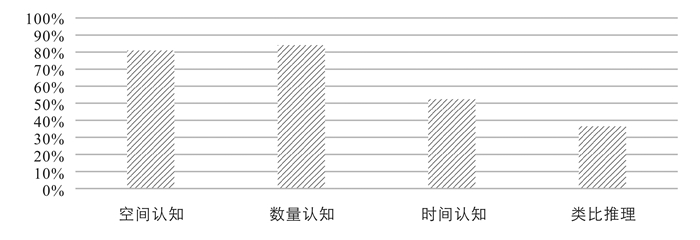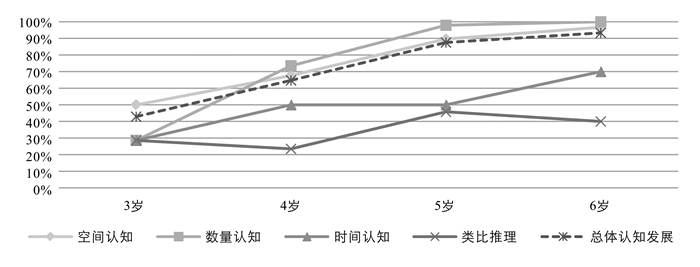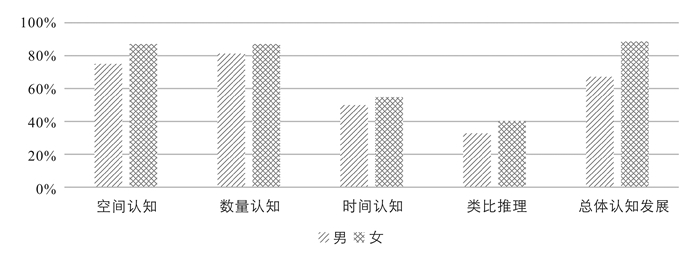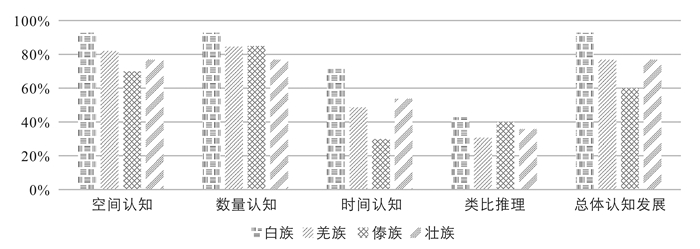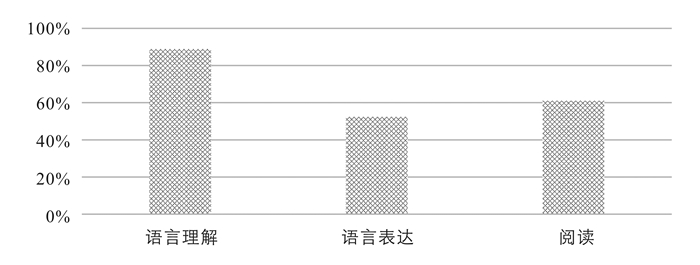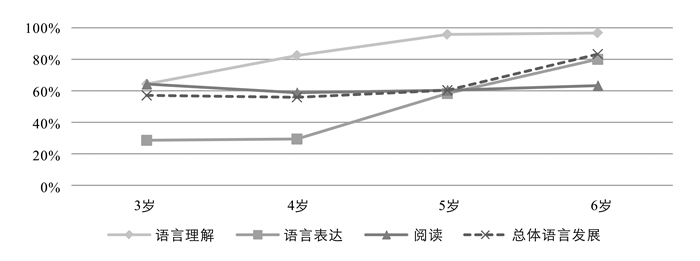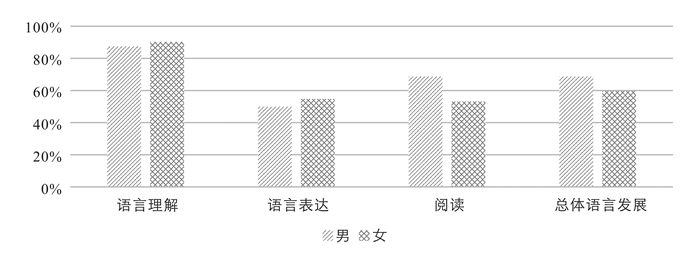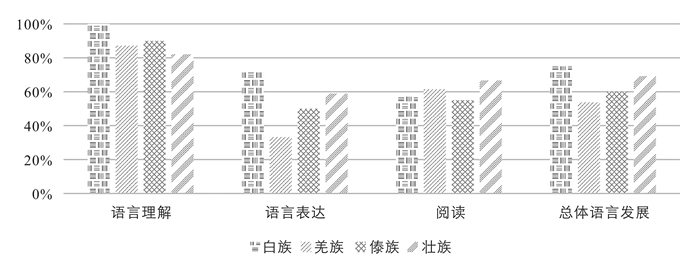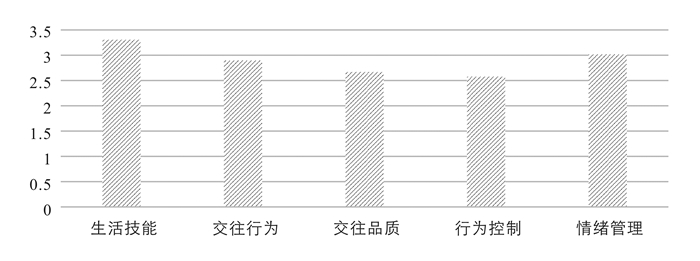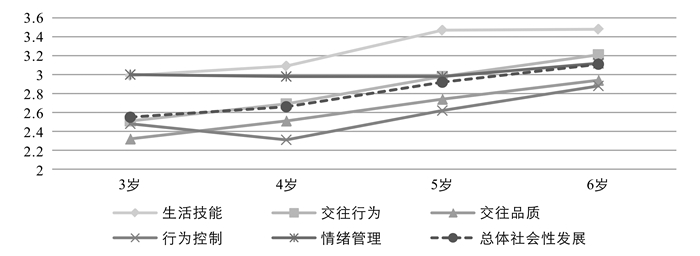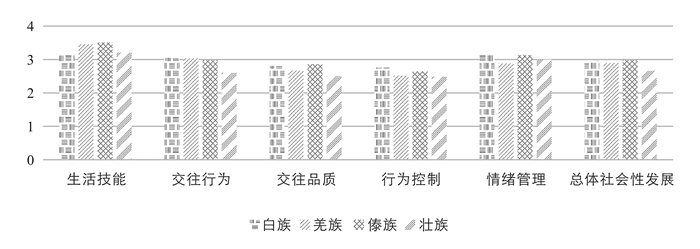全文HTML
-
儿童发展寄托着亿万家庭对美好生活的期望,也决定着国家未来和民族希望,是关乎民生福祉和国家发展的大事[1]4。随着经济社会的发展,我国已在多项与儿童发展相关的事业上取得显著进展,但0~6岁儿童不充分养育和教育及地区间发展不均衡等问题依然凸显。边远贫困地区、民族村落地区儿童发展面临诸多问题与挑战。第六次人口普查数据显示,我国现有少数民族儿童3 063万人,其中71.4%生活在村落地区,50.6%生活在贫困县村落[2-3]。因此,要实施乡村振兴战略,实现“到2020年全面建成小康社会,任何一个地区、任何一个民族都不能落下”,关注和研究少数民族地区村落儿童的发展问题迫在眉睫。然而,民族地区村落儿童,尤其是少数民族聚居的西南地区村落儿童的发展究竟是什么状况、面临着什么问题、是什么原因导致这些问题,对此尚缺乏系统、深入的研究。本研究旨在通过对西南民族地区村落3~6岁儿童体质健康、认知、语言和社会性发展状况的调查,掌握西南民族地区村落学前儿童发展的基本现状、突出问题及其影响因素,为政府探索符合少数民族地区村落儿童的发展路径,切实保障所有儿童公平发展,实施乡村振兴战略提供决策参考。
-
本研究选取了云南省大理白族自治州和西双版纳傣族自治州、四川省北川羌族自治县、广西壮族自治区靖西市4个地区9个村落幼儿园的白、傣、羌、壮4个民族的3~6岁儿童作为研究对象。
1.民族地区村落学前儿童体质健康研究采取整群随机抽样法,抽取了9个村落幼儿园的25个班级共650名3~6岁少数民族儿童作为测查对象。剔除数据不全和民族不符的样本,最终得到有效样本520人。其中,3岁组95人、4岁组169人、5岁组175人、6岁组81人,白族154人、羌族52人、傣族116人、壮族198人,男童269人、女童251人。
2.民族地区村落学前儿童认知发展、语言发展、社会性发展研究采取目的抽样法,抽取了9个村落幼儿园的126名3~6岁少数民族儿童作为测查对象。其中,3岁组14人、4岁组34人、5岁组48人、6岁组30人,白族28人、羌族39人、傣族20人、壮族39人,男童64人、女童62人。
-
基于我国少数民族地区村落儿童发展的特点,参考《国民体质测定标准手册(幼儿部分)》[4]、《幼儿园教育质量评价手册》[5],借鉴国外相关研究项目所用工具和关键指标,结合《3~6岁儿童学习与发展指南》[6]编制了民族地区村落学前儿童成长与发展调查工具。主要包括:
1.《我国民族地区村落3~6岁儿童体质健康测查表》。测查内容包括身高、体重、10米折返跑、立定跳远、网球掷远、双脚连续跳、走平衡木7个项目。其中,身高、体重反映儿童体格发育水平;年龄别身高、年龄别体重和身高别体重反映儿童营养状况;10米折返跑、立定跳远、网球掷远、双脚连续跳、走平衡木反映儿童身体素质。测试方法遵照《国民体质测定标准手册(幼儿部分)》对各项指标测查的相关要求。评价依据为国家体育总局发布的“2014年全国3~6岁幼儿各项体质指标均值”[7]、WHO儿童生长标准[8]和《儿童健康检查服务技术规范》[9]。
2.《我国民族地区村落3~6岁儿童认知发展/语言发展测查表》。测查内容包括认知发展(空间认知、数量认知、时间认知、类比推理)和语言发展(语言理解、语言表达、阅读)。选择儿童熟悉且安静的幼儿园活动室为测试地点,由接受专业培训的研究者对儿童进行一对一施测;儿童根据题目要求通过图片指认、实际操作、口头回答等方式作答,研究者即时评分记录;每位儿童测试时间为45分钟左右。
3.《我国民族地区村落3~6岁儿童社会性发展调查问卷》。调查内容包括生活技能、交往行为、交往品质、行为控制、情绪管理5个维度34个项目。每个项目分为4个等级,由样本班主班教师进行评分。
-
本研究使用SPSS 22.0进行数据录入、处理和分析。运用描述统计对儿童体质健康、认知、语言和社会性发展的均值进行分析;运用单样本T检验,比较样本儿童体质健康数据与2014年全国3~6岁幼儿体质监测数据的差异及显著性;运用卡方检验,分析不同年龄、性别、民族儿童的营养状况、认知和语言发展合格率①的差异及显著性;运用独立样本T检验和方差分析,检验儿童社会性发展的年龄、性别、民族差异及显著性。
① 本研究中的合格率是指各维度通过率≥60%的人数比率,通过率为某维度实际得分/该维度总分*100。
一. 研究对象
二. 研究工具
三. 数据处理
-
1.体格发育状况
(1) 整体情况。四个民族地区村落学前儿童的体格发育水平均落后于全国平均水平,尤其是3~5岁儿童体格发育显著落后于全国平均水平(p<0.001)。由表 1可见,3~6岁男女样本儿童体格发育水平均低于全国均值。其中,男童身高低0.33cm~6.15cm,女童身高低0.71cm~4.79cm;男童体重低0.90kg~2.29kg,女童体重低1.79kg~1.98kg。单样本T检验发现,3~5岁男女童的身高(t=-8.66、-6.60、-6.78、-7.33、-5.03、-5.06;p<0.001)、3~5岁男童的体重(t=-10.21、-10.89、-6.93;p<0.001)、3~6岁女童的体重(t=-7.41、-9.54、-6.01、-4.72;p<0.001)与全国均值呈显著差异,明显落后于全国平均水平。
(2) 年龄差异。图 1显示,样本儿童体格发育的均值随年龄增大而逐渐递增。3~6岁儿童身高均值分别为M3岁=96.08、M4岁=103.42、M5岁=110.27、M6岁=118.38,体重均值分别为M3岁=14.15、M4岁=15.88、M5岁=18.06、M6岁=20.86。经方差分析,不同年龄段之间存在显著差异(F身高=300.25,P<0.001;F体重=111.84,P<0.001)。事后比较发现,6岁组儿童体格发育水平显著高于5岁组,5岁组儿童显著高于4岁组,4岁组儿童显著高于3岁组。可见,民族地区村落学前儿童的体格发育水平随年龄增长而提升,发育趋势良好。
(3) 性别差异。男童的体格发育均值(M身高=107.51、M体重=17.72)略高于女童(M身高=106.56、M体重=16.76)(见图 2),男童的体重显著高于女童(t体重=2.25,P<0.05)。
(4) 民族差异。四个民族村落样本儿童体格发育的均值依次为白族>羌族>傣族>壮族。其中,身高均值依次为M白族=113.12、M羌族=107.92、M傣族=107.82、M壮族=100.80,体重均值依次为M白族=18.94、M羌族=17.65、M傣族=17.29、M壮族=15.43(见图 3)。经方差分析,四个民族样本儿童体格发育差异显著(F身高=83.56,p<0.001;F体重=35.66,p<0.001)。事后比较发现,白族儿童的体格发育显著优于其他三个民族,壮族儿童的体格发育显著低于其他三个民族。
2.营养状况
(1) 整体情况。四个民族村落样本儿童的生长迟缓率(H/A<M-2SD)为10.2%、低体重率(W/A<M-2SD)为6.2%、消瘦率(W/H<M-2SD)为3.1%、超重率(M+1SD<W/H<M+2SD)为4.4%、肥胖率(W/H≥M+2SD)为1.2%(见表 2)。其生长迟缓率、超重率和肥胖率低于全国农村水平,而低体重率和消瘦率则高于全国贫困农村水平①。
① 2013年全国6岁以下儿童的生长迟缓率农村为11.3%、贫困农村为19.0%,低体重率农村为3.2%、贫困农村为5.1%,消瘦率农村为2.4%、贫困农村为2.7%,超重率农村为8.4%,肥胖率农村为2.9%。参见:国家卫生计生委疾病预防控制局.中国居民营养与慢性病状况报告[M].北京:人民卫生出版社,2015:21-28.
(2) 年龄差异。表 2显示,3~6岁样本儿童的生长迟缓率分别为16.8%、10.7%、8.6%、4.9%;低体重率分别为5.3%、5.3%、6.9%、7.4%;消瘦率分别为2.1%、2.4%、3.4%、4.9%;超重率分别为4.2%、6.5%、4.0%、1.2%;肥胖率分别为1.1%、0%、1.1%、3.7%。可见,四个民族地区村落学前儿童的生长迟缓率和超重率随年龄的增长不断下降,低体重率、消瘦率和肥胖率随年龄的增长不断上升。进一步卡方检验发现,不同年龄段样本儿童营养状况的差异无显著性(p>0.05)。
(3) 性别差异。表 2显示,样本男童的生长迟缓率为11.2%、女童为9.2%;男童的低体重率为5.9%、女童为6.4%;男童的消瘦率为3.0%、女童为3.2%;男童的超重率为5.2%、女童为3.6%;男童的肥胖率为1.9%、女童为0.4%。可见,样本男童的生长迟缓率、超重率、肥胖率高于女童,低体重率和消瘦率低于女童。进一步卡方检验发现,不同性别样本儿童营养状况的差异无显著性(p>0.05)。
(4) 民族差异。四个民族样本儿童的生长迟缓率排序为壮族(20.7%)>羌族(5.8%)>傣族(4.3%)>白族(2.6%);低体重率排序为傣族(9.5%)>壮族(8.6%)>白族/羌族(1.9%);消瘦率排序为傣族(5.2%)>白族(3.2%)>壮族(2.0%)>羌族(1.9%);超重率排序为羌族(7.7%)>壮族(5.6%)>傣族(3.4%)>白族(2.6%);肥胖率排序为傣族(2.6%)>白族(1.3%)>壮族(0.5%),羌族无肥胖儿童。经卡方检验,四个民族村落样本儿童的生长迟缓率存在显著差异(χ2=39.12,p<0.001),壮族儿童的生长迟缓率显著高于其他三个民族。低体重率Bonferroni校正调整后的显著性水平均大于0.05,不存在显著差异。
3.身体素质发育状况
(1) 整体情况。四个民族村落学前儿童的灵敏素质、爆发力、上肢及腰腹肌肉力量均落后于全国平均水平,而协调性及下肢肌肉力量和平衡能力优于全国平均水平。
由表 3可见,在灵敏素质方面,3~6岁男女样本儿童的10米折返跑用时均高于全国均值。其中,男童高0.39s~1.56s、女童高0.2s~1.69s。单样本T检验发现,4~6岁女童(t4岁=2.34,p<0.05;t5岁=4.92,p<0.001;t6岁=6.74,p<0.001)及5~6岁男童(t5岁=3.61,p<0.01;t6岁=8.30,p<0.001)10米折返跑用时与全国均值呈显著差异,明显落后于全国平均水平。
在爆发力方面,3~6岁男女样本儿童的立定跳远成绩均低于全国均值。其中,男童低1.43cm~7.87cm、女童低0.29cm~8.5cm。单样本T检验发现,3~5岁男童(t3岁=-2.74,p<0.01;t4岁=-2.79,p<0.01;t5岁=-2.45,p<0.05)及4岁组女童(t4岁=-4.29,p<0.001)的立定跳远成绩与全国均值差异显著,明显落后于全国平均水平。
在上肢及腰腹肌肉力量方面,3岁组和6岁组男女样本儿童的网球掷远成绩低于全国均值。其中,3岁组男童低0.62m、女童低0.4m,6岁组男童低1.11m、女童低0.81m。单样本T检验发现,3岁组和6岁组男童(t3岁=-3.44,p<0.01;t6岁=-3.97,p<0.001)与女童(t3岁=-3.26,p<0.01;t6岁=-3.26,p<0.01)的网球掷远成绩与全国均值呈显著差异,明显落后于全国平均水平。
在协调性及下肢肌肉力量方面,3~6岁男女样本儿童的双脚连续跳用时均低于全国均值。其中,男童低0.33s~1.73s、女童低0.5s~2.77s。单样本T检验发现,3~5岁男童(t3岁=-3.78,p<0.001;t4岁=-6.52,p<0.001;t5岁=-3.94,p<0.001)和女童(t3岁=-5.46,p<0.001;t4岁=-7.18,p<0.001;t5岁=-6.25,p<0.001)双脚连续跳用时与全国均值差异显著,明显优于全国平均水平。
在平衡能力方面,3~5岁男女样本儿童走平衡木用时均低于全国均值。其中,男童低0.69s~4.17s、女童低1.46s~5.53s。单样本T检验发现,3~4岁男童(t3岁=-3.10,p<0.01;t4岁=-4.20,p<0.001)与3~5岁女童(t3岁=-5.45,p<0.001;t4岁=-5.55,p<0.001;t5岁=-3.85,p<0.001)走平衡木用时与全国均值差异显著,明显优于全国平均水平。
(2) 年龄差异。图 1显示,样本儿童各项身体素质指标均值呈现出随年龄增加而增长的总体趋势。3~6岁儿童10米折返跑用时均值分别为M3岁=9.58、M4岁=8.61、M5岁=7.99、M6岁=8.43;立定跳远均值分别为M3岁=58.44、M4岁=70.89、M5岁=89.83、M6岁=103.14;网球掷远均值分别为M3岁=2.89、M4岁=4.42、M5岁=5.68、M6岁=5.84,双脚连续跳用时均值分别为M3岁=7.40、M4岁=6.13、M5岁=5.54、M6岁=5.34;走平衡木用时均值分别为M3岁=12.15、M4岁=8.83、M5岁=7.38、M6岁=6.59。经方差分析,各年龄段之间差异存在显著性(F10米折返跑=15.89,p<0.001;F立定跳远=110.29,p<0.001;F网球掷远=56.25,p<0.001;F双脚连续跳=20.02,p<0.001;F走平衡木=16.69,p<0.001)。事后比较发现,6岁组儿童的爆发力水平显著高于5岁组,5岁组儿童身体素质发育各项水平显著高于4岁组,4岁组儿童身体素质发育各项水平显著高于3岁组。
(3) 性别差异。男童的灵敏素质、爆发力、上肢及腰腹肌肉力量水平(M10米折返跑=8.47;M立定跳远=82.19;M网球掷远=5.23)略高于女童(M10米折返跑=8.83;M立定跳远=78.96;M网球掷远=4.19),协调性及下肢肌肉力量和平衡能力水平(M双脚连续跳=6.18;M走平衡木=8.92)略低于女童(M双脚连续跳=6.03;M走平衡木=8.56)(见图 2)。独立样本T检验发现,男童的上肢及腰腹肌肉力量显著优于女童(t网球掷远=4.92,p<0.001)。
(4) 民族差异。图 3显示,四个民族样本儿童的灵敏素质水平排序为傣族(M10米折返跑=7.63)>壮族(M10米折返跑=8.34)>白族(M10米折返跑=9.20)>羌族(M10米折返跑=9.42);爆发力水平排序为傣族(M立定跳远=84.48)>白族(M立定跳远=84.19)>羌族(M立定跳远=83.12)>壮族(M立定跳远=73.18);上肢及腰腹肌肉力量水平排序为傣族(M网球掷远=5.51)>白族(M网球掷远=4.81)>壮族(M网球掷远=4.49)>羌族(M网球掷远=4.24);协调性及下肢肌肉力量水平排序为傣族(M双脚连续跳=4.17)>壮族(M双脚连续跳=6.19)>白族(M双脚连续跳=6.45)>羌族(M双脚连续跳=8.54);平衡能力水平排序为傣族(M走平衡木=5.54)>白族(M走平衡木=6.40)>壮族(M走平衡木=10.41)>羌族(M走平衡木=14.97)。经方差分析,不同民族儿童的身体素质发育各项水平均存在显著差异(F10米折返跑=22.74,p<0.001;F立定跳远=8.53,p<0.001;F网球掷远=7.12,p<0.001;F双脚连续跳=68.14,p<0.001;F走平衡木=46.28,p<0.001)。事后比较发现,傣族儿童的灵敏素质、上肢及腰腹肌肉力量、协调性及下肢肌肉力量显著好于其他三个民族;羌族的协调性及下肢肌肉力量和平衡能力显著低于其他三个民族;壮族儿童的灵敏素质显著好于白族和羌族,平衡能力显著低于白族和傣族,爆发力显著低于其他三个民族。
-
1.整体情况。图 4显示,样本儿童认知发展各维度合格率分别为:数量认知84.1%、空间认知81.0%、时间认知52.4%、类比推理36.5%。可见,民族地区村落学前儿童的数量认知和空间认知发展较好,时间认知和类比推理发展较差。
2.年龄差异。随年龄的增长,样本儿童的认知发展水平显著提高(χ2=20.06,P<0.001),认知发展趋势良好(见图 5)。其中,空间认知(χ2=19.73,P<0.001)和数量认知(χ2=47.71,P<0.001)的年龄差异显著。卡方检验发现,6岁组儿童的总体认知发展和空间认知水平显著高于4岁组和3岁组,5岁组儿童显著高于3岁组;6岁组和5岁组儿童的数量认知水平显著高于4岁组和3岁组,4岁组儿童显著高于3岁组。
3.性别差异。图 6显示,空间认知、数量认知、时间认知、类比推理、总体认知发展合格率女童分别为87.1%、87.1%、54.8%、40.3%、88.7%,男童分别为75.0%、81.3%、50.0%、32.8%、67.2%。卡方检验发现,男女童的总体认知发展合格率存在显著差异,女童明显高于男童(χ2=8.44,p<0.01)。
4.民族差异。图 7显示,四个民族样本儿童的总体认知发展合格率排序为白族(92.9%)>羌族/壮族(76.9%)>傣族(60.0%)。其中,空间认知合格率排序为白族(92.9%)>羌族(82.1%)>壮族(76.9%)>傣族(70.0%);数量认知合格率排序为白族(92.9%)>羌族(84.6%)>傣族(85.0%)>壮族(76.9%);时间认知合格率排序为白族(71.4%)>壮族(53.8%)>羌族(48.7%)>傣族(30.0%);类比推理合格率排序为白族(42.9%)>傣族(40.0%)>壮族(35.9%)>羌族(30.8%)。卡方检验发现,四个民族的时间认知(χ2=8.33,P<0.05)存在显著差异,白族儿童的时间认知水平显著高于傣族。
-
1.整体情况。图 8显示,样本儿童语言发展各维度合格率分别为:语言理解88.9%、语言表达52.4%、阅读61.1%。可见,民族地区村落学前儿童的语言理解能力较好,语言表达和阅读能力欠佳。
2.年龄差异。样本儿童语言发展水平随年龄增长呈上升趋势(见图 9),且差异显著(χ2=13.50,P<0.01)。其中,语言理解(χ2=14.23,P<0.01)和语言表达(χ2=20.23,P<0.001)的年龄差异显著。卡方检验发现,6岁组儿童的总体语言发展水平显著高于4岁组;6岁组和5岁组儿童的语言理解能力显著高于3岁组;6岁组儿童的语言表达能力显著高于4岁组和3岁组。
3.性别差异。图 10显示,语言理解、语言表达、阅读的合格率,女童分别为90.3%、54.8%、53.2%,男童分别为87.5%、50.0%、68.8%。女童的语言理解和语言表达合格率高于男童,男童的阅读合格率高于女童。卡方检验发现,男女童的语言发展各项合格率均无显著差异(P>0.05)。
4.民族差异。图 11显示,四个民族样本儿童的总体语言发展合格率排序为白族(75.0%)>壮族(69.2%)>傣族(60.0%)>羌族(53.8%)。其中,语言理解合格率排序为白族(100%)>傣族(90.0%)>羌族(87.2%)>壮族(82.1%);语言表达合格率排序为白族(71.4%)>壮族(59.0%)>傣族(50.0%)>羌族(33.3%);阅读合格率排序为壮族(66.7%)>羌族(61.5%)>白族(57.1%)>傣族(55.0%)。卡方检验发现,四个民族的语言表达水平存在显著差异(χ2=10.47,p<0.05),白族儿童的语言表达能力显著优于羌族。
-
1.整体情况。图 12显示,样本儿童的生活技能(M=3.31)得分较高,情绪管理(M=3.02)和交往行为(M=2.90)得分次之,交往品质(M=2.67)和行为控制(M=2.58)得分较低。从具体项目来看,领导欲(M=2.24)、移情(M=2.30)、协商(M=2.36)、注意力(M=2.40)、完成任务(M=2.41)、好奇心(M=2.47)等方面得分较低;独立脱衣(M=3.34)、洗手(M=3.33)、收拾物品(M=3.30)、独立穿衣(M=3.27)等生活技能得分较高,其生活自理能力较强。可见,民族地区村落学前儿童的生活技能发展较好,交往品质和行为控制发展欠佳。
2.年龄差异。样本儿童的社会性发展水平随年龄增加而增长(见图 13),且呈显著差异(F=9.48,P<0.001)。除情绪管理(F=0.50,P>0.05)外,生活技能(F=5.26,P<0.01)、交往行为(F=8.28,P<0.001)、交往品质(F=8.25,P<0.001)、行为控制(F=5.08,P<0.01)的年龄差异显著。事后比较发现,6岁组和5岁组儿童的总体社会性发展及生活技能显著高于4岁组和3岁组;6岁组儿童的交往行为和交往品质发展水平显著高于4岁组和3岁组,5岁组儿童显著高于3岁组;6岁组儿童的行为控制水平显著高于4岁组。
3.性别差异。图 14显示,女童的总体社会性发展及各因子(M总体社会性发展=2.92、M生活技能=3.33、M交往行为=2.97、M交往品质=2.76、M行为控制=2.70、M情绪管理=3.04)得分均略高于男童(M总体社会性发展=2.78、M生活技能=3.29、M交往行为=2.83、M交往品质=2.60、M行为控制=2.47、M情绪管理=3.00)。独立样本T检验发现,女童的行为控制能力显著高于男童(t=-2.10,p<0.05)。
4.民族差异。图 15显示,四个民族样本儿童总体社会性发展的均值排序为傣族(M=2.98)>白族(M=2.96)>羌族(M=2.90)>壮族(M=2.66)。其中,生活技能均值排序为傣族(M=3.51)>羌族(M=3.46)>壮族(M=3.21)>白族(M=3.12);交往行为均值排序为白族(M=3.05)>羌族(M=3.04)>傣族(M=2.98)>壮族(M=2.60);交往品质均值排序为傣族(M=2.86)>白族(M=2.81)>羌族(M=2.67)>壮族(M=2.50);行为控制均值排序为白族(M=2.76)>傣族(M=2.65)>羌族(2.52)>壮族(M=2.49);情绪管理均值排序为白族(M=3.14)>傣族(M=3.13)>壮族(M=3.00)>羌族(M=2.88)。方差分析发现,四个民族儿童的总体社会性发展(F=3.66,p<0.05)、交往行为(F=5.54,p<0.01)和交往品质(F=3.51,p<0.05)存在显著差异。多重比较可知,壮族儿童的总体社会性发展水平显著低于白族,交往行为显著低于白族和羌族,交往品质显著低于白族和傣族。
一. 民族地区村落学前儿童体质健康状况
二. 民族地区村落学前儿童认知发展状况
三. 民族地区村落学前儿童语言发展状况
四. 民族地区村落学前儿童社会性发展状况
-
目前,云南、四川、广西的9个村落4个少数民族3~6岁儿童的体质健康、认知、语言和社会性发展呈现如下特征和状况。
-
民族村落学前儿童的身体协调性及下肢肌肉力量和平衡能力发展显著高于全国平均水平,体格发育、灵敏素质、爆发力、上肢及腰腹肌肉力量落后于全国平均水平。目前民族村落儿童仍有10.2%的生长迟缓,6.2%的低体重和3.1%的消瘦,且低体重率和消瘦率高于全国贫困农村水平,营养问题较为凸显。究其主要原因,一是由于贫困、照料人缺乏科学养育知识,使得儿童膳食中优质蛋白、钙、铁等营养素和热量摄入不足。二是村落医疗服务资源不足,儿童患病后得不到及时医治。三是母亲生育低龄化,导致儿童体质健康的先天不足和后天发育不良。研究显示,25岁以下母亲生育儿童的出生低体重率是25~35岁母亲的2倍[1]55。四是村落儿童留守率高,父母养育缺位,儿童生命早期缺乏安全的亲子依恋关系,导致其生长素分泌不足,压力激素分泌过多,从而造成体格发育不足,免疫力、记忆力等下降,身心健康受到影响。相关研究表明,母亲外出打工的1岁半以下儿童的生长迟缓率是母亲在家儿童的1.5倍[1]56。
-
不同于数量的理解和记忆,时间认知和类比推理是较高阶的思维能力。类比推理是问题解决中经常使用的策略,时间认知影响着儿童信息加工能力的提高[10]。已有研究发现,思考、提取、记住信息和解决问题的能力,以及进行其他复杂的符号性活动如口语、阅读、书写、算术和社会行为的能力,都依赖于注意、记忆和执行性功能的发展[11]97。村落学前儿童的注意力和坚持性发展较差也在一定程度上影响着其认知发展。此外,儿童的许多重要学习和发现并不仅仅来自个体的探索,而是产生于成人和儿童的互动,这种互动有助于儿童对更为成熟的思维方式和解决问题的策略进行内化[12]。而村落儿童家长多从事传统的农业劳动,在繁重的生活压力下极少有抚养人关注到儿童的思维训练。村落幼教班/点教师又多为散养式或看管式教育,对儿童的身心发展规律不甚了解,加之缺乏相应的课程和教材,只能“把自己会的都教给她们”,识字做题的知识训练便成为教育内容及方式的首选。
-
研究发现,民族地区村落学前儿童的汉语理解能力相对较好,汉语表达和阅读能力相对不足。在与民族村落学前儿童的交流中,普遍存在“不知如何说”“怕说”“无话可说”的情况。究其原因可能为:一是民族语言的影响。汉语中的某一表达在本民族语言中常有多种说法,这可能会给儿童的认知学习和语言表达带来困难[13]。二是早期语言学习经验不足。从理解和表达的内容看,幼儿的语言主要是在一定的情境中使用而获得发展的,因此其内容以来源于幼儿生活经验的具体事物和事件为主[14]。然而,民族村落年轻父母多外出打工,祖辈照看的情况居多。年纪大的祖辈只会讲本地的“土话”,不会说汉语,使得部分儿童不仅缺乏汉语的知识经验和生活体验,也缺乏汉语表达的机会和自信,难以准确丰富地进行自我表达。三是阅读经验的匮乏。阅读可以促进儿童对书本的积极态度,激励儿童词汇量的增长,这一干预对处于最严重困境的儿童最有效[15]。而村落学前儿童的家庭和幼儿园中几乎没有阅读教育,缺乏能够扩展他们的世界以及提升口语技能的教育资源。
-
研究发现,民族地区村落学前儿童的领导欲、移情、协商、好奇心等交往品质欠佳,注意力、完成任务、坚持性等行为控制水平不足。国际经验表示,用于提高儿童基本读写能力和数的能力的资源,应该改其方向,用在培养儿童早期学习环境中的好奇心、自我导向和坚持性的发展,与他人合作,关爱他人和解决同伴冲突的能力等方面[11]335。综合已有研究来看,儿童与成人的互动关系极大地影响着其早期社会交往的充分发展和协商合作等技能的掌握。家长和教师敏感温暖的互动、对探索的鼓励、让儿童感觉到安全和被爱等因素会帮助其学习和掌握社会技能并与他人建立友谊。当成人能够给予积极的情感支持、材料支持和策略支持,儿童的探究行为水平将得到有效提升[16-17]。教师敏感、正向、温暖的情感支持和课堂组织也与儿童的好奇心、注意力与坚持性等社会性品质的发展紧密相关[18]。
-
本研究结果显示,民族村落学前儿童的体质健康、认知、语言和社会性发展均呈现显著年龄差异,年龄越大的儿童在各维度的表现越好。其中,5~6岁儿童发展水平的提高较为明显。这一结果的可能原因,一是随着年龄的自然增长,儿童的大脑发育逐渐完善,认知能力、语言的表达与理解能力在不断提升,社会性交往水平也随之提升,获得快速发展[19]。二是进入幼儿园接受学前教育为儿童发展带来了显著的积极影响。民族村落儿童在接受了1~2年学前教育后,其认知、语言和社会性发展水平得以显著提升。已有研究发现,农村学前儿童的学前教育经历会显著影响其入学认知准备[20]。接受2年及以上学前教育的儿童在身体健康、社会性发展等多方面优于未接受学前教育的儿童[21]。当地教师也反映,少数民族幼儿在家极少接受过普通话教育,经过一年多的汉语教育,逐渐破解语言关后,儿童的认知、交往和学业水平会有明显提升。
-
性别差异分析发现,男童的体格、灵敏素质、爆发力、上肢及腰腹肌肉力量优于女童,尤其是体重和上肢及腰腹力量显著优于女童,而女童在协调性及下肢肌肉力量、平衡能力、认知发展、语言理解、语言表达、社会性发展优于男童,尤其在认知发展和行为控制方面显著优于男童。这一结果与国内外多项研究结论一致。男童在强调力量的动作能力上要超过女童,而女童的整体协调性优于男童[22]。除运动能力外,女孩在所有领域都比男孩发育得更好[23]。在认知和语言发展领域,女孩通常比男孩表现更好[24]。这可能受社会态度和教养方式的影响,男孩通常被要求成为积极的、体能强的人,女孩则被要求成为安静听话的人。在学习和完成任务时,女孩表现出更强的专注力和坚持性,在情感和行为上易得到教师和家长的认同与表扬[25-26]。
-
民族差异分析发现,白族村落学前儿童的体格发育显著优于其他三个民族,时间认知水平显著高于傣族,语言表达能力显著优于羌族,社会性发展水平显著优于壮族,整体发展水平较好。这可能是由于,白族样本儿童多生活在坝区,交通方便,与城市的交流频繁,容易获取外界信息,得到外来支援。同时,白族的汉化时间早、汉化程度较高,长期形成了重视读书和学习的文化信念。在村民的观念中,学前教育是促进幼儿未来发展的有效工具,得到了村落精英和民众的支持[27]。
傣族村落学前儿童的身体素质发育优于其他三个民族,交往品质表现较好,但认知发展欠佳。这一结果可能受傣族独特的自然地理环境和民族文化环境的影响。西双版纳的M镇毗邻缅甸,自然资源丰富,橡胶产业和边贸较为发达,经济发展水平较好。一方面,富足的生活为傣族儿童提供了良好的膳食营养和宽松的环境氛围,使儿童的身体素质和交往能力更强。另一方面,家长对儿童受教育的需求并不强烈。对傣族人而言,割胶、边贸等收入足以让他们过上衣食无忧的生活,他们并没有改变现状、获取知识、融入现代社会的强烈愿望。这样的村落文化也在潜移默化中作用于傣族儿童的学习和发展。
羌族村落学前儿童的各方面发展均不突出,主要体现在身体素质发育、类比推理、语言表达和社会交往能力方面。究其原因可能为本次调研的羌族村落位于龙门山地震带上,经常发生泥石流和公路塌方,交通不便。一方面,复杂险恶的地理环境阻碍了羌族儿童对外界信息的获取,客观上制约了学前教育的发展。另一方面,汶川地震对羌族人民生活环境和社会文化的破坏以及带来的重新生育等问题也可能会影响着羌族儿童的心理发展。
壮族村落学前儿童的各方面发展均欠佳,生长迟缓率显著高于其他三个民族,体格、身体素质发育和社会性发展等均不足。相较于其他三个民族,壮族村落儿童的膳食结构尤为单一,儿童一日膳食以米粉为主,蔬菜和肉蛋类食物较少;同时,“少女妈妈”现象突出、留守率高。本研究中约60%的壮族儿童是由祖辈照看的留守儿童,而祖父母文化水平普遍偏低,难以提供学习与发展方面的支持以及情感上的沟通交流,育儿环境较差。
一. 身体协调性及下肢肌肉力量、平衡能力发展较好,体格发育、灵敏素质、爆发力、上肢及腰腹肌肉力量较差,营养问题较为凸显
二. 数量认知和空间认知发展较好,时间认知和类比推理发展较差
三. 语言(汉语)理解能力较好,语言(汉语)表达和阅读能力较差
四. 生活技能发展较好,交往品质和行为控制发展欠佳
五. 各维度发展水平随年龄增长而提高,5~6岁发展较为明显
六. 男童的体重和上肢及腰腹肌肉力量优于女童,女童的认知发展和行为控制能力优于男童
七. 白族儿童整体发展较好,傣族儿童身体素质发育较好,羌族和壮族儿童整体发展水平欠佳
-
通过对西南地区的四个少数民族村落学前儿童发展现状、问题与成因的分析与反思,要促进民族村落学前儿童的健康成长需要整合多方力量,透过政府与家庭、幼儿园、社区的深度合作,形成保障儿童健康发展的公众认知和支持系统[28]。
-
相较于民族村落学前儿童的教育问题,其医疗和营养问题更为突出。从专业的角度而言,必须整合医学和教育的力量,为村落学前儿童及其家庭提供教育、医疗、营养等综合性社会服务来提高儿童的认知和社会性发展,促进儿童做好入学准备。建议在推行“一村一幼”的同时,同步实施一村/多村一医。一方面,改善当地的医疗条件,提高卫生服务质量,让儿童生病时能及时就医,降低村落学前儿童的疾病风险。另一方面,以儿科诊所或幼儿园作为服务干预的站点,医生和护士在对儿童进行健康检查时为家长科普妇幼保健和早期养育知识,增强家庭卫生医疗信息的获取能力[29],并为家长提供发展适宜性的养育指导,保障村落儿童在健康安全的环境中和亲密包容的关系中获得成长。
-
在教师专业发展条件十分有限的民族村落地区,教材往往是重要的教学资源。适宜的课程或教材能够保证教师选择教学内容的科学性和合理性,扩展村落儿童的认知经验。而当前民族村落地区的幼教点很少有专门的教材,甚至缺乏基本教学材料。教师们只能选择照搬县城幼儿园的教材或者随意教授一些自己会的知识,常常造成教学内容脱离儿童生活经验,甚至缺乏科学性。当地政府亟须抓好民族本土课程和教材的研发工作,编制反映村落学前儿童熟悉的生活和文化的乡土教材,为村落幼儿教师提供操作性较强的教学方案和教学用书,扩展教育教学内容,丰富儿童的认知经验,保证民族地区村落儿童早期发展与教育的基本质量[30]。同时,组织开发幼儿园课程和教材应该是集合专家、村落教师、家长以及当地有文化的长者和村民等利益相关方共同组成的专业研发和维护运营团队,建设适合民族地区村落文化和教育实际的课程资源,而不能只是仅凭经验的闭门造车。
-
民族地区幼儿教师数量不足、基本素质不达标是导致少数民族学前教育质量较差的重要因素。为此建议,一是实行“乡来乡去”的定向培养计划。首先通过基线调查,了解各民族村落需要的幼儿教师数量,检核师资缺口,再向距离较近的高水平院校协商分配定向培养名额,与毕业后愿意回到乡村从教的当地学生签订6~8年的服务合同,以保证优质师资的培养和供给。二是重构民族村落幼儿园教师的专业发展支持体系。一方面,建立分层分阶段的精准培训体系。精准识别民族村落教师的培训需求,根据教师当前的能力和发展需求,对处于不同发展阶段和水平的教师分层分阶段培训。如对普通话仍未掌握的教师优先考虑语言培训,对双语掌握较好、专业能力不足的教师重点进行专业培训。同时,转变培训理念,支持民族村落地区的网络建设,以互联网和移动设备等信息技术灵活支持村落教师的在线学习和优质培训资源的提供[31]。另一方面,尊重村落幼儿园教师的精神需求,给予村落幼儿园教师足够的情感支持。由于村落地区生活条件较为艰苦,教育设施简陋,需要教师付出较大的情感投入,应注重完善各级政府保障机制,增强乡村教师乡土安全感;健全乡村社会关爱机制,强化乡村教师乡土归属感;加强教师情感修养机制,激发自身乡土责任感[32]。
-
家庭早期教养质量对儿童的短期和终身发展都有极其重要的影响,因此为家庭提供早期教养的支持与服务是保证儿童健康成长的重要路径。国外实践经验表明,“入户指导”是改善家庭教养环境的有效手段[33]。为此,建议组建专业的家庭入户指导团队,招聘有经验的教育和卫生部门专业人员到民族村落地区开展专业干预与指导服务,与儿童进行游戏互动,提升家长的营养和教育知识,给予母亲最大的社会支持,降低家长的育儿压力,减少家庭问题和儿童成长风险。其指导服务包括家庭生活和子女教育的教育服务、养育能力提升的指导服务和家庭教养问题及心理支持的咨询服务。后续进行干预经验的总结和追踪评估,形成“低成本、广覆盖、有质量、可推广”的特色村落家庭干预服务模式。



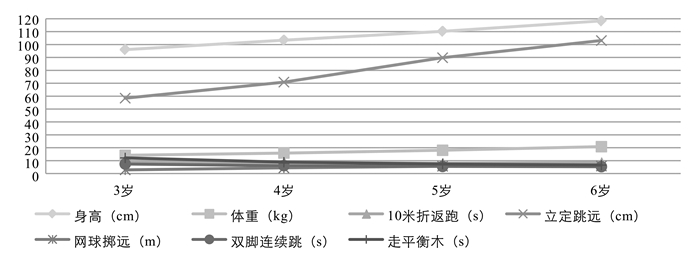
 下载:
下载:


